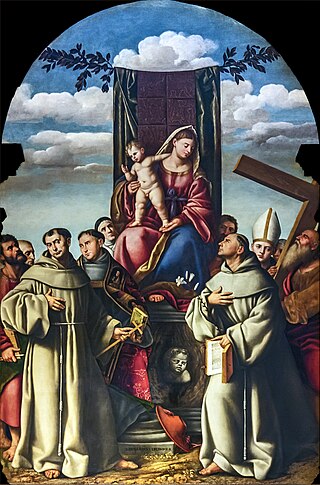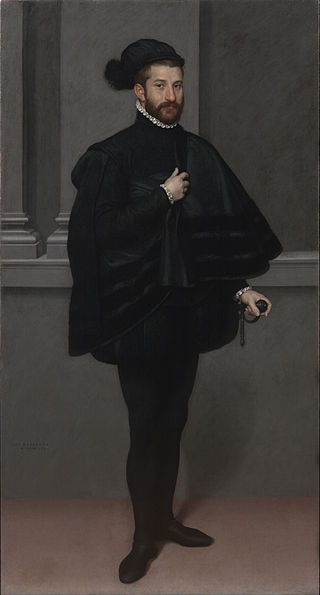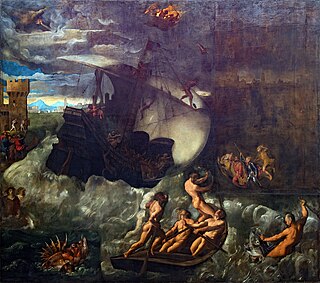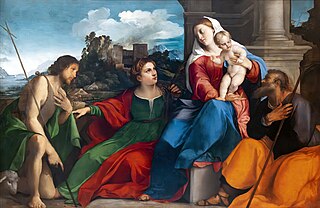
Giovanni Battista Moroni was an Italian painter of the Mannerism. He also is called Giambattista Moroni. Best known for his elegantly realistic portraits of the local nobility and clergy, he is considered one of the great portrait painters of the Cinquecento.

Alessandro Bonvicino, more commonly known as Moretto, or in Italian Il Moretto da Brescia, was an Italian Renaissance painter from Brescia, where he also mostly worked. His dated works span the period from 1524 to 1554, but he was already described as a master in 1516. He was mainly a painter of altarpieces that tend towards sedateness, mostly for churches in and around Brescia, but also in Bergamo, Milan, Verona, and Asola; many remain in the churches they were painted for. The majority of these are on canvas, but a considerable number, including some large pieces, are created on wood panels. There are only a few surviving drawings from the artist.

Bernardino Licinio was an Italian High Renaissance painter of Venice and Lombardy. He mainly painted portraits and religious canvases.

Fra’ Galgario, born Giuseppe Vittore Ghislandi, and also called Fra’ Vittore del Galgario, was an Italian painter, mainly active in Bergamo as a portraitist during the Rococo or late-Baroque period.

Giovanni Giacomo Barbelli was an Italian painter of the Baroque period, active in Lombardy. He was a canvas and fresco painter known for his religious and mythological scenes that decorate many churches and residences in Lombardy. He was a highly skilled draughtsman and a brilliant colorist. His work shows an inventive imagination and a thorough knowledge of perspective.

The Tailor is an oil on canvas painting by Italian painter Giovanni Battista Moroni, from 1565-1570. It is a portrait of a member of the Marinoni family, who has been traditionally taken to be a tailor practising his art during the work day. The painting is held in the National Gallery, in London.

The Knight in Black is an oil on canvas portrait painting of an unknown male subject by Giovanni Battista Moroni, from c. 1567. It is held in the Museo Poldi Pezzoli, in Milan.

The Pralboino Altarpiece is an oil on canvas altarpiece, of 1540–1545 and measuring 356 x 225 cm, by Moretto da Brescia in the church of Sant'Andrea in Pralboino, Province of Brescia, Italy. The work's upper register shows the Madonna and Child with Francis of Assisi and Saint Joseph, whilst below are saints Jerome, Louis of Toulouse, Anthony of Padua, Clare of Assisi and the painting's commissioner, cardinal Uberto Gambara, member of a local family. It was originally in the same town's Franciscan church of Santa Maria degli Angeli.

Mystic Marriage of Saint Catherine or Mystic Betrothal of Saint Catherine is a 1567-1570 oil on panel painting by Giovanni Battista Moroni, produced for the side-altar of Catherine of Alexandria in the church of San Bartolomeo, parish church of Almenno San Bartolomeo, where it still hangs. It is signed at lower right IO:BAP.MORONUS.P. The church had been begun in 1520 through the will of Giorgio Rota, but work lapsed until restarting in 1562. The painting draws on the composition of Moretti's 1539 Rovelli Altarpiece.

Count Guglielmo Lochis was an Italian nobleman, politician, art collector and art connoisseur.

The Saint Helena Altarpiece is a three-panelled oil on panel painting by Jacopo Palma il Vecchio, created c. 1524–1525, now in the Pinacoteca di Brera in Milan.

Adoration of the Shepherds with a Donor is an oil painting on canvas executed c.1520–1525 by the Venetian painter Palma Vecchio, now in room 711 of the Louvre in Paris.

Storm at Sea or Saints Mark, George and Nicholas Freeing Venice from Demons is a c. 1528 oil on canvas painting by Palma Vecchio, now in the Gallerie dell'Accademia in Venice. It was partly completed in 1535 by Paris Bordon after Palma's death.

Madonna and Child with Saints is a c. 1520 oil on panel painting by Palma Vecchio, now in room XVI of the Accademia Carrara in Bergamo, the artist's birthplace. It is first recorded as part of the collection of Guglielmo Lochis, who acquired it in 1830 from Cristoforo Orsetti, one of the most important Venetian collectors of that era.

Portrait of a Courtesan or Portrait of a Woman is a c. 1520 oil on canvas painting by Palma Vecchio, now in the Museo Poldi Pezzoli in Milan.

Holy Family with Saint John the Baptist and Saint Catherine is a c. 1520-1528 oil on canvas painting by Palma Vecchio, now in the Gallerie dell'Accademia in Venice. It was completed by Titian after Palma's death.

The Portrait of Alessandro Vittoria is an oil on canvas painting created by Italian painter Giovanni Battista Moroni, in 1551–1552. It is held at the Kunsthistorisches Museum, in Vienna.

The Portrait of a Man Holding a Letter, also known as The Lawyer, is an oil on canvas painting by Italian painter Giovanni Battista Moroni, from 1570-1572. It is held at the National Gallery, in London. It is considered one of the most representative paintings of the artist's maturity.

Portrait of a Lady, also known as The Lady in Red is an oil on canvas painting by Italian painter Giovanni Battista Moroni, from c. 1556–1560. It is believed to depict Countess Lucia Albani Avogadro, a 16th-century Italian poet. It is held in the National Gallery, in London.

The Knight in Pink is an oil on canvas painting by Italian painter Giovanni Battista Moroni, from 1560. It depicts a nobleman, Gian Gerolamo Grumelli, and is one of the artist's best-known portraits. It is held in the Palazzo Moroni, in Bergamo.




















